Chain Slings
Recommended Chain Sling Use
Follow these Recommendations for Safer Chain Sling Use
Chain Sling Working Load Limits by Leg
| SPECIFICATIONS | |||
| SIZE OF CHAIN | GRADE 80 WORKING LOAD LIMITS* LBS. at 90° | GRADE 100 WORKING LOAD LIMITS* LBS. at 90° | |
| In. | mm | ||
| 9/32 | 7 | 3,500 | 4,300 |
| 3/8 | 10 | 7,100 | 8,800 |
| 1/2 | 13 | 12,000 | 15,000 |
| 5/8 | 16 | 18,100 | 22,600 |
| 3/4 | 20 | 28,300 | 35,300 |
| 7/8 | 22 | 34,200 | 42,700 |
| 1 | 26 | 47,700 | — |
| 1-1/4 | 32 | 72,300 | — |
| SPECIFICATIONS | |||
| SIZE OF CHAIN | GRADE 80 WORKING LOAD LIMITS* LBS. at 60° | GRADE 100 WORKING LOAD LIMITS* LBS. at 60° | |
| In. | mm | ||
| 9/32 | 7 | 6,100 | 7,400 |
| 3/8 | 10 | 12,300 | 15,200 |
| 1/2 | 13 | 20,800 | 26,000 |
| 5/8 | 16 | 31,300 | 39,100 |
| 3/4 | 20 | 49,000 | 61,100 |
| 7/8 | 22 | 59,200 | 74,000 |
| 1 | 26 | 82,600 | — |
| 1-1/4 | 32 | 125,200 | — |
| SPECIFICATIONS | |||
| SIZE OF CHAIN | GRADE 80 WORKING LOAD LIMITS* LBS. at 60° | GRADE 100 WORKING LOAD LIMITS* LBS. at 60° | |
| In. | mm | ||
| 9/32 | 7 | 9,100 | 11,200 |
| 3/8 | 10 | 18,400 | 22,900 |
| 1/2 | 13 | 31,200 | 39,000 |
| 5/8 | 16 | 47,000 | 58,700 |
| 3/4 | 20 | 73,500 | 91,700 |
| 7/8 | 22 | 88,900 | 110,900 |
| 1 | 26 | 123,900 | — |
| 1-1/4 | 32 | 187,000 | — |
| SPECIFICATIONS | |||
| SIZE OF CHAIN | GRADE 80 WORKING LOAD LIMITS* LBS. at 60° | GRADE 100 WORKING LOAD LIMITS* LBS. at 60° | |
| In. | mm | ||
| 9/32 | 7 | 9,100 | 11,200 |
| 3/8 | 10 | 18,400 | 22,900 |
| 1/2 | 13 | 31,200 | 39,000 |
| 5/8 | 16 | 47,000 | 58,700 |
| 3/4 | 20 | 73,500 | 91,700 |
| 7/8 | 22 | 88,900 | 110,900 |
| 1 | 26 | 123,900 | — |
| 1-1/4 | 32 | 187,000 | — |
Chain Sling Inspection
Daily Inspection — as shown in No. 1
Recommendations — should be conducted by a competent person designated by the employer.
Periodic Inspection — OSHA specifies that all alloy steel chain slings shall have a thorough periodic inspection, by a competent person, at least once every 12 months. These inspections must be recorded and
maintained for each individual sling.
The inspection schedule should be based on frequency of sling use, severity of service conditions, nature of lifts being made and experience gained on service life of slings used in similar circumstances
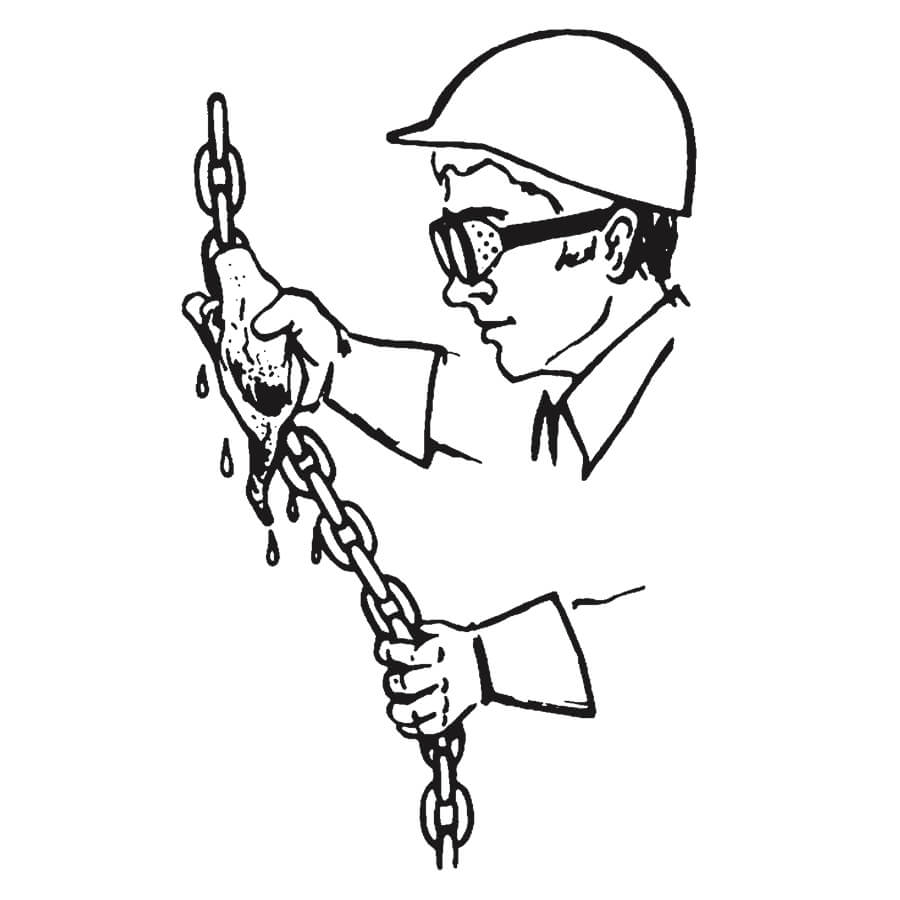
Inspection
1. Clean chain prior to inspection, to more easily see damage or defects.
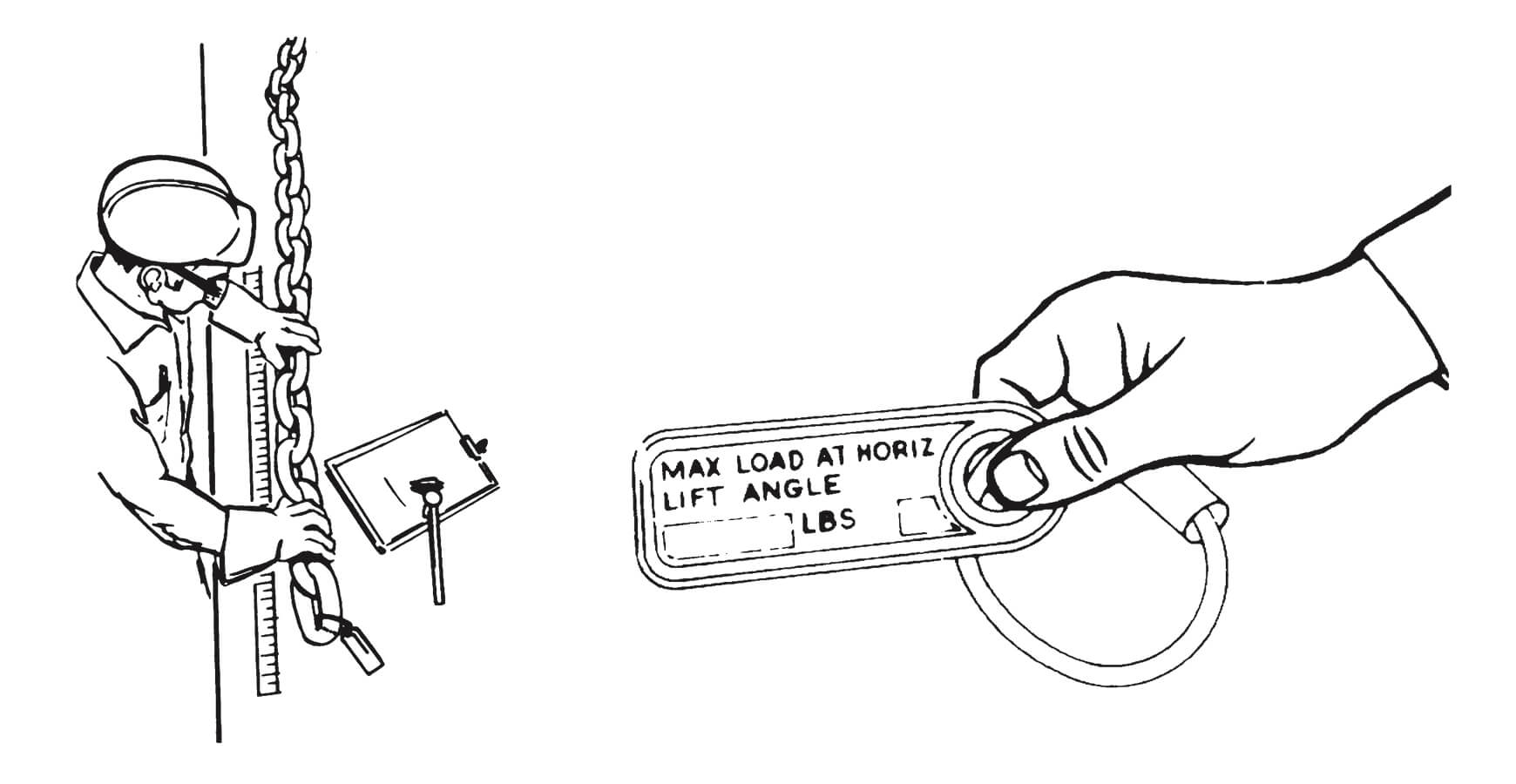
a. Excessive wear — If the wear on any portion of any link exceeds the allowable wear shown in Table of Wear remove from service.
b. Twisted, bent, gouged, nicked, worn or elongated links.
c. Cracks in the weld area of any portion of the link.
Transverse markings are the most dangerous.
d.Severe corrosion.
4. Check master links and hooks for all of the above faults — hooks especially for excessive throat opening. Slings showing any of the faults described above should immediately be removed from service and returned to the manufacturer for repair.
Certex offers a chain sling inspection service performed by our own qualified inspectors.
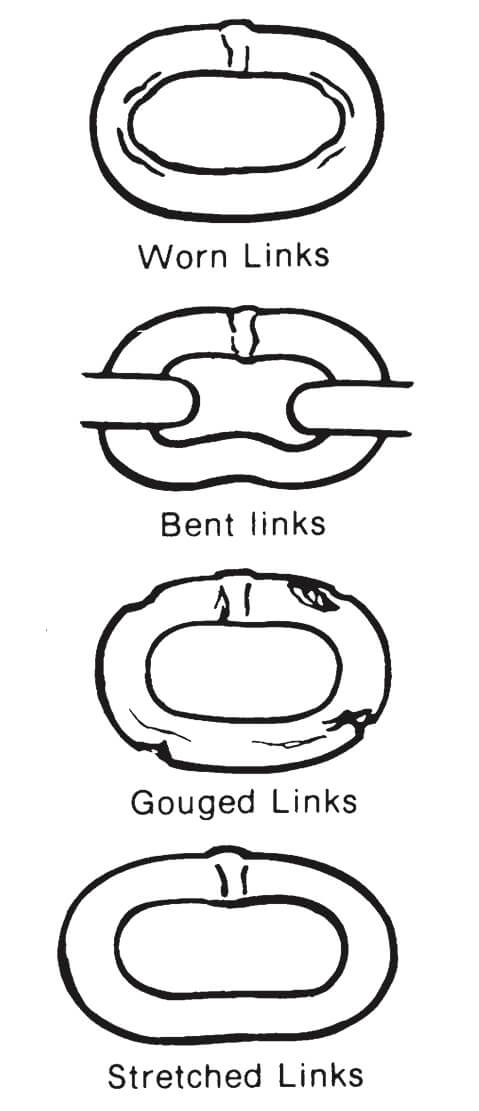
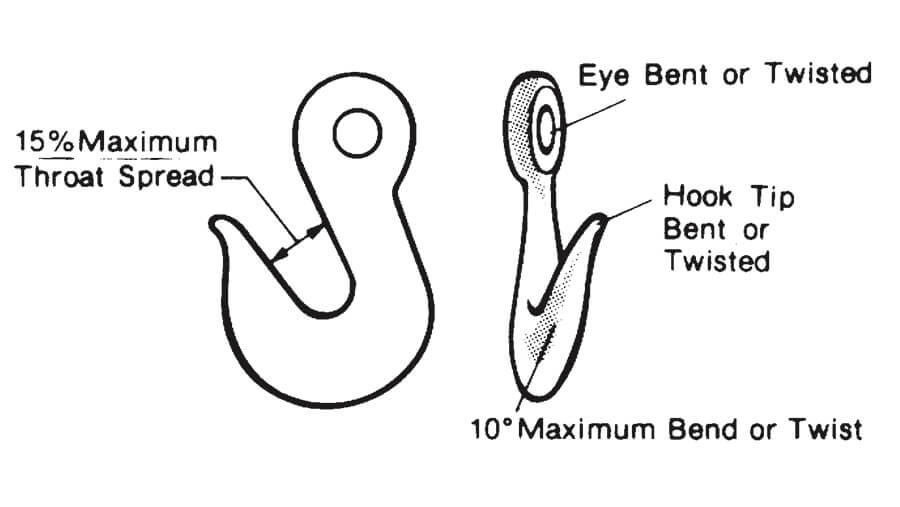
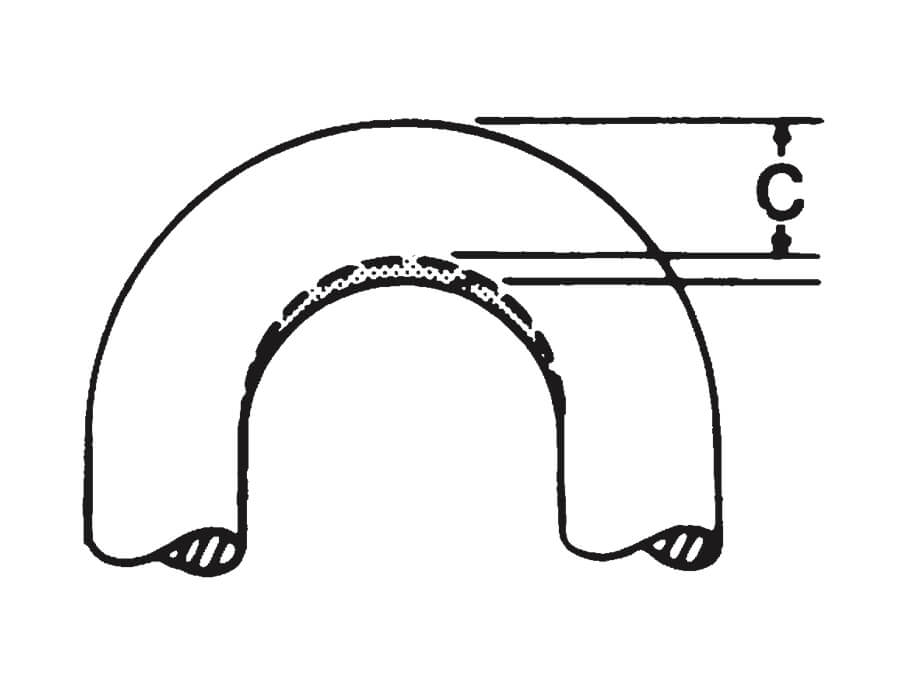
Types of Chain Slings
Single Chain Slings
The following information should be given on orders or inquiries for chain slings.
1. SIZE: This is specified by the size of the material from which the chain is made, determined by working load limit required.
2. REACH: This is the length, including attachments, measured from bearing point to bearing point.
3. TYPE: Select and specify proper type of sling from list shown. EXAMPLES: S—single, O—oblong link, S—sling hook.
4. ATTACHMENTS: Unless otherwise specified standard master links and hooks as given herein will be used. When other than standard master links or hooks are required, we should be given a complete description or a drawing of the requested substitute.
.
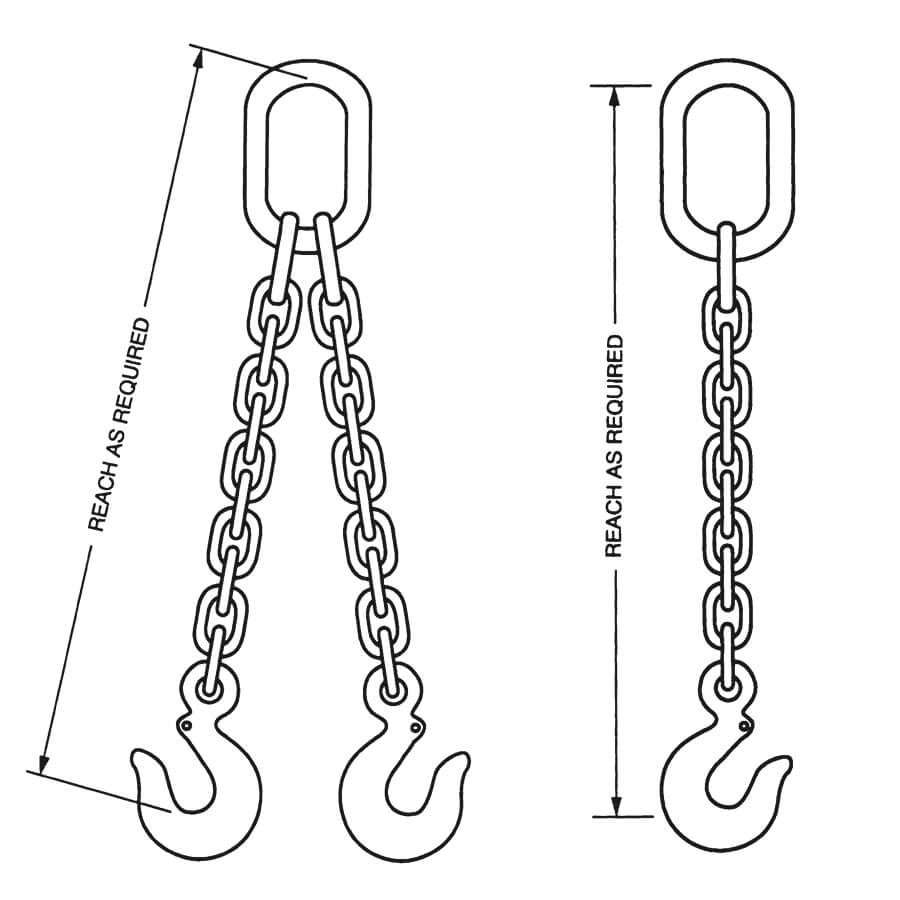
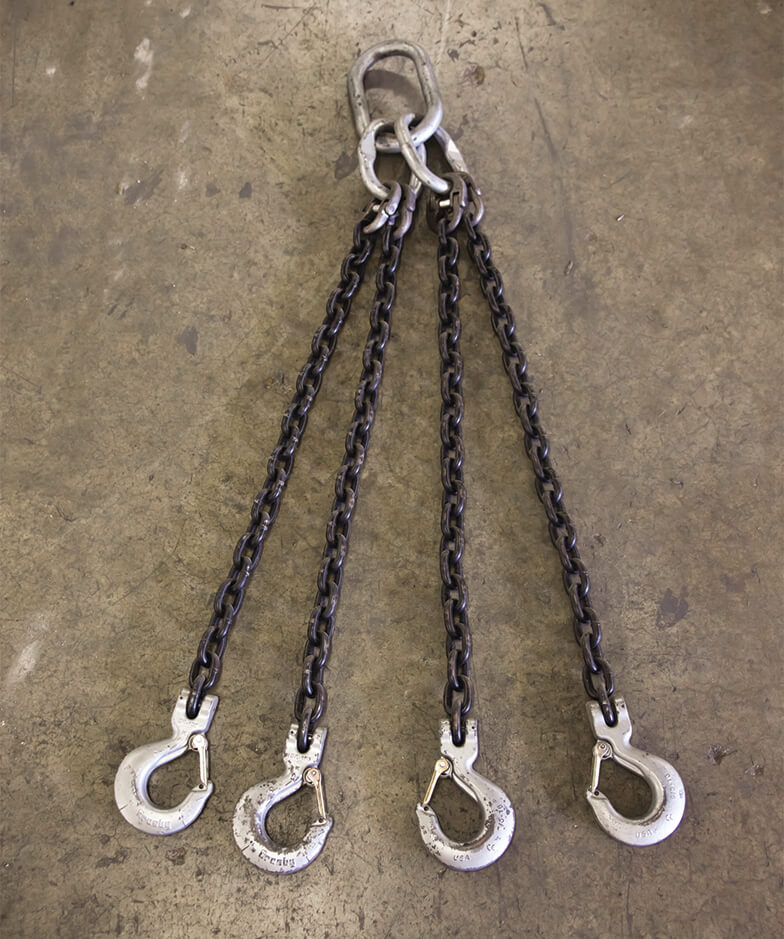
| Single Chain Slings | ||
| Attachments | ||
| Type | One End | Opposite End |
| SG | Plain | Grab Hook |
| SOS | Oblong Link | Single Hook |
| SOG | Oblong Link | Grab Hook |
| SGS | Grab Hook | Sling Hook |
| SGG | Grab Hook | Grab Hook |
| SSS | Sling Hook | Sling Hook |
| SOF | Oblong Link | Foundry Hook |
| CO | Oblong Link | Oblong Link |
| Double Chain Slings | ||
| DOS | Oblong Link | Sling Hooks |
| DOG | Oblong Link | Grab Hooks |
| DOF | Oblong Link | Foundry Hooks |
| DOP | Oblong Link | Plate Hooks |
| Triple Chain Slings | ||
| TOS | Oblong Link | Sling Hooks |
| TOG | Oblong Link | Grab Hooks |
| TOF | Oblong Link | Foundry Hooks |
| Quadruple Chain Slings | ||
| QOS | Oblong Link | Single Hooks |
| QOG | Oblong Link | Grab Hooks |
| QOF | Oblong Link | Foundry Hooks |
WARNING:
Failure to read, understand and follow the instructions, working load limits and specifications in this and other publications could result in serious injury or property damage.
Recommended Chain Sling Use
Follow these Recommendations for Safer Chain Sling Use
Visually examine the sling before each use. Look for stretched, gouged, bent or damaged links and components, including hooks, with opened throats, cracks or distortion. If damaged, remove from service.
” dsm_show_dir=”on” dsm_dir_color=”#000000″ dsm_image=”https://www.certex.com/wp-content/uploads/2024/02/Recommended-Chain-Sling-Use-fig1.jpg” title_text=”Recommended Chain Sling Use fig1″ dsm_image_width=”80%” dsm_dir_width=”30px” dsm_badge_position=”top_center” _builder_version=”4.24.0″ _module_preset=”default” dsm_badge_text_font_size=”17px” background_color=”#FFFFFF” hover_enabled=”0″ global_colors_info=”{}” sticky_enabled=”0″ _i=”0″ _address=”2.1.0.0″ /]
Know the load — determine the weight, center of gravity, angle of lift and select the proper size and type of sling.
” dsm_show_dir=”on” dsm_dir_color=”#000000″ dsm_image=”https://www.certex.com/wp-content/uploads/2024/02/Recommended-Chain-Sling-Use-fig2.jpg” title_text=”Recommended Chain Sling Use fig2″ dsm_image_width=”100%” dsm_dir_width=”40px” dsm_badge_position=”top_center” _builder_version=”4.24.0″ _module_preset=”default” dsm_badge_text_font_size=”17px” background_color=”#FFFFFF” module_alignment=”center” min_height=”100%” height=”100%” max_height=”100%” hover_enabled=”0″ global_colors_info=”{}” sticky_enabled=”0″ _i=”0″ _address=”2.1.1.0″ /]
Never overload the sling — check the working load limit on the identification tag. Always consider the effect of Angle of Lift — the tension on each leg of the sling is increased as the angle of lift, from horizontal, decreases. Use the charts in this catalog or in the Acco Chain Sling User’s Manual for this purpose.
” dsm_show_dir=”on” dsm_dir_color=”#000000″ dsm_image=”https://www.certex.com/wp-content/uploads/2024/02/Recommended-Chain-Sling-Use-fig3.jpg” title_text=”Recommended Chain Sling Use fig3″ dsm_image_width=”100%” dsm_dir_width=”40px” dsm_badge_position=”top_center” _builder_version=”4.24.0″ _module_preset=”default” dsm_badge_text_font_size=”17px” background_color=”#FFFFFF” module_alignment=”center” min_height=”100%” height=”100%” max_height=”100%” hover_enabled=”0″ global_colors_info=”{}” sticky_enabled=”0″ _i=”0″ _address=”2.2.0.0″ /]
Do not point load hooks — load should bear on the bowl of hook.
” dsm_show_dir=”on” dsm_dir_color=”#000000″ dsm_image=”https://www.certex.com/wp-content/uploads/2024/02/Recommended-Chain-Sling-Use-fig4.jpg” title_text=”Recommended Chain Sling Use fig4″ dsm_image_width=”80%” dsm_dir_width=”30px” dsm_badge_position=”top_center” _builder_version=”4.24.0″ _module_preset=”default” dsm_badge_text_font_size=”17px” background_color=”#FFFFFF” hover_enabled=”0″ global_colors_info=”{}” sticky_enabled=”0″ _i=”0″ _address=”2.3.0.0″ /]
Make sure chain is not twisted, knotted or kinked before lifting the load.
” dsm_show_dir=”on” dsm_dir_color=”#000000″ dsm_image_width=”100%” dsm_dir_width=”40px” dsm_badge_position=”top_center” _builder_version=”4.23.4″ _module_preset=”default” dsm_badge_text_font_size=”17px” background_color=”#FFFFFF” module_alignment=”center” min_height=”100%” height=”100%” max_height=”100%” hover_enabled=”0″ global_colors_info=”{}” sticky_enabled=”0″ _i=”0″ _address=”2.3.1.0″ /]
Slings should not be shortened with knots, bolts or other makeshift devices
” dsm_show_dir=”on” dsm_dir_color=”#000000″ dsm_image_width=”100%” dsm_dir_width=”40px” dsm_badge_position=”top_center” _builder_version=”4.23.4″ _module_preset=”default” dsm_badge_text_font_size=”17px” background_color=”#FFFFFF” module_alignment=”center” min_height=”100%” height=”100%” max_height=”100%” global_colors_info=”{}” _i=”0″ _address=”2.3.2.0″ /]
Protect chain with padding when lifting sharp edged loads.
” dsm_show_dir=”on” dsm_dir_color=”#000000″ dsm_image=”https://www.certex.com/wp-content/uploads/2024/02/Recommended-Chain-Sling-Use-fig5.jpg” title_text=”Recommended Chain Sling Use fig5″ dsm_image_width=”65%” dsm_dir_width=”40px” dsm_badge_position=”top_center” _builder_version=”4.24.0″ _module_preset=”default” dsm_badge_text_font_size=”17px” background_color=”#FFFFFF” module_alignment=”center” min_height=”100%” height=”100%” max_height=”100%” hover_enabled=”0″ global_colors_info=”{}” sticky_enabled=”0″ _i=”0″ _address=”2.4.0.0″ /]



11. Protect chain slings from corrosion during storage.
12. Store slings properly on an A-Frame.
Grade 10 chain slings
Working Load Limits in tonnes for chain slings grade 10
Based on EN 818-4:2008 WLL +25%

| Chain Size (mm) | Chain Size (in) | WLL (lb) | ||||||
|---|---|---|---|---|---|---|---|---|
| 6 | – | 3300 | 5500 | 4625 | 3300 | 8400 | 6800 | 4850 |
| 7 | 9/32″ | 4300 | 7400 | 6100 | 4300 | 11200 | 9100 | 6400 |
| 8 | 5/16″ | 5700 | 9900 | 8100 | 5700 | 14800 | 12100 | 8500 |
| 10 | 3/8″ | 8800 | 15200 | 12400 | 8800 | 22900 | 18700 | 13200 |
| 13 | 1/2″ | 15000 | 26000 | 21200 | 15000 | 39000 | 31800 | 22500 |
| 16 | 5/8″ | 22600 | 39100 | 32000 | 22600 | 58700 | 47900 | 33900 |
| 20 | 3/4″ | 35300 | 61100 | 49900 | 35300 | 91700 | 74900 | 52950 |
| 22 | 7/8″ | 42700 | 74000 | 60400 | 42700 | 110900 | 90600 | 64000 |
| 26 | 1″ | 59700 | 103100 | 84100 | 59500 | 155600 | 126600 | 89250 |
| 32 | 1-1/4″ | 88160 | 152700 | 124600 | 88160 | 229000 | 186950 | 132200 |

